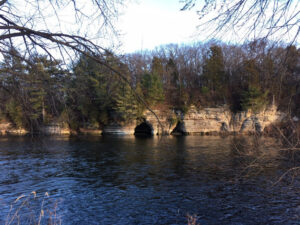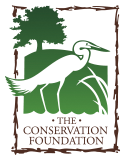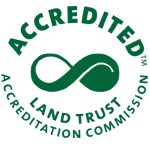The Curving Landscape of Dayton Bluffs
A conservation land trust is a non-profit organization that preserves and manages land for future generations. Conservation land trusts protect sites of cultural, historical, or natural significance. The Conservation Foundation is a conservation land trust. Conservation land trusts have — at the core of their mission — to preserve and restore our natural landscapes, while also providing benefits for landowners and communities. Conservation land trusts also play a major role in helping mitigate the negative impacts of climate change. They use a variety of tools to help landowners voluntarily protect their land.
What are the benefits?
The lands protected by conservation land trusts help provide clean water and air, protect habitat for wildlife and plants, and help mitigate the impacts of climate change. Some land trusts work in urban locations, creating community gardens, protecting green spaces, and planting trees that cool air temperatures and reduce air pollution. Ultimately, land trusts provide the benefits expected from land and water conservation. Conservation helps with carbon sequestration, preventing significant greenhouse gas emissions, providing habitats for wildlife, and building communities resilient to the effects of climate change. For a deeper discussion on the economic benefits of land conservation see The Economic Benefits of Land Conservation.
How do they work?
Conservation land trusts work for private and public land. There are many options available to help landowners preserve, protect, and restore land. Two of the most popular options are fee simple and conservation easements. The fee simple option has the conservation land trust owning and managing the land that is donated or sold. A conservation easement is where landowners and a land trust enter a legal agreement to permanently limit the use of an area to protect conservation values. Landowners can either sell or donate the easement to land trusts. Landowners retain ownership of the land, can sell their land in the future, or pass it on. But the conservation restrictions remain forever.
It is important to note that conservation land trusts can be accredited. Accreditation is awarded to land trusts meeting the highest national standards for excellence and conservation permanence. The accreditation program is run by The Land Trust Accreditation Commission, an independent program of Land Trust Alliance, a national conservation organization in the United States. The Conservation Foundation, for example, is an accredited land trust.
The financial aspects of conservation land trusts can be interesting for the original owners of the land as well as for the surrounding community. For the landowner, there are the tax benefits derived from the donation of the land as well as the reduced costs of maintaining the land. For the surrounding community, two potential benefits are having higher residential land values and avoided municipal services. Essentially, it’s about the cost of community services provided to development, especially new development, versus the tax revenue gained from the development. Open space preservation is also a good land use planning tool to manage and direct development and growth into preferred areas. To quote Brook McDonald , CEO and President of The Conservation Foundation, “open space is the ultimate tax cap.”
What has The Conservation Foundation been doing?
The Conservation Foundation itself is a conservation land trust, one of many in the state of Illinois. In fact, there is a state-wide professional association of Illinois conservation land trusts called the Prairie State Conservation Coalition (PSCC), of which The Conservation Foundation is a member and The Conservation Foundation’s own Brook McDonald is currently the President. Collectively, these organizations have helped protect more than 250,000 acres of open space in Illinois. View more details on the organization and find land trusts near you.
The Conservation Foundation is accredited by the Land Trust Accreditation Commission. The Conservation Foundation has helped preserve more than 36,000 acres. Two examples of their work are the Dayton Bluffs property and the Belrose Farm property along the lower Fox River near Ottawa, IL.
Dayton Bluffs
On July 31, 2013, The Conservation Foundation became the owner of Dayton Bluffs, an ecological and archaeological wonderland.
A partnership of The Conservation Foundation and the City of Ottawa created the Dayton Bluffs Preserve, a 253-acre natural area preserve along the Fox River established for the citizens of Ottawa, LaSalle County and all of Illinois. With generous funding from the Illinois Clean Energy Community Foundation, Grand Victoria Foundation, and the Hamill Family Foundation, The Conservation Foundation was able to purchase the Dayton Bluffs Preserve for $2.1 million. Through a very creative partnership agreement, The Conservation Foundation leases the Dayton Bluffs Preserve to the City of Ottawa who manages it as a public preserve. The land was designated as an Illinois Land and Water Reserve by the Illinois Nature Preserves Commission in 2014.
The Conservation Foundation owns the land and is responsible for its initial restoration and long-term ecological management. The City of Ottawa is responsible for daily access, security, and general maintenance. The all-volunteer Friends of the Dayton Bluffs helps maintain the natural areas on the property.
Belrose Farm
Belrose Farm had been in the same family for the last 140 years until the end of 2021, when the family decided the time had come to sell it. Boasting 183 acres, a mix of productive farmland, forested ravines, scenic St. Peter sandstone bluffs, and a mile of frontage along the Fox River near Serena, IL (LaSalle County), the property holds appeal for a wide variety of buyers from farmers to developers to sand companies to hunters and outdoor enthusiasts. And having been identified on a 1999 survey by the Illinois Department of Natural Resources as one of the top 20 highest quality natural areas in the Lower Fox River watershed, it most certainly holds appeal from a conservation standpoint, as well.

Fox River Frontage of Belrose Farm
After a series of complex financial transactions involving an initial auction for the land, follow-up grants from the Illinois Clean Energy Community Foundation, funding from the Hamill Family Foundation, and generous private donations from two local donors, The Conservation Foundation became the owner of Belrose Farm.
So, what makes this place worth the two weeks of scramble and stress and sleepless nights? Waterfalls, sandstone bluffs, upland forests, lowland swamps, 300+ year old oak trees, a unique slot canyon known as Hidden Shelter Canyon, almost a mile of Fox River frontage, and a rare hill prairie are just some of the site’s most charismatic features. And human history is as important as the natural history of Belrose Farm. There is abundant archaeological evidence of the property’s extensive use by Indigenous peoples before the Belrose Family came to it in the 1800s.
Dan Lobbes, The Conservation Foundation’s Director of Land Preservation, points to the preservation of Belrose Farm as one of the highlights of his career. “There are some very special places that will always stand out to me, and Belrose Farm is certainly one of them. It’s one of those hidden gems, rare places that nobody has really gotten to see, but now a lot more people will get to experience it and enjoy it the way that I do.”
For more details about Belrose Farm and its acquisition, read Belrose Farm: A Land of Stories by The Conservation Foundation’s Jill Johnson.
What can you do?
Many landowners would like to sell or donate their property to local open space agencies, but don’t know who to call. Since we have been working with public agencies throughout northeastern Illinois since 1972, we can put you or the interested landowner in touch with the right people at the appropriate agencies.
Outside of providing land, how can you contribute to land and water conservation efforts that help with carbon sequestration, preventing significant greenhouse gas emissions, providing habitats for wildlife, and building communities resilient to the effects of climate change? Well, land and water conservation are what The Conservation Foundation does every day. We can all do more together than we can alone. Join our collective momentum – become a member today!
Feel free to comment on this blog with your ideas on conservation land trusts.
By Steve Stawarz, Oak Brook
DuPage County Advisory Council Member



